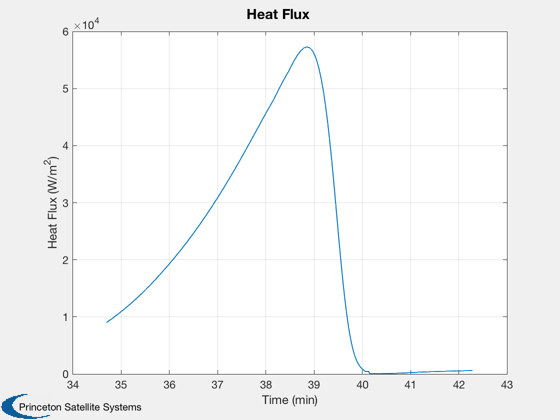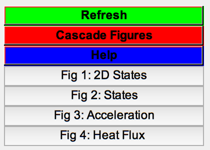A reentry simulation with lift and drag forces. Uses LiftingReentry3D.m
The vehicle starts at 380 km, the ISS altitude. It does a delta-v to do a Hohmann transfer to 40 km where drag causes reentry. You can control reentry using angle of attack (d.alpha). ------------------------------------------------------------------------ See also Plot2D, TimeLabl, Dot, Mag, RK4, Unit, DVHoh, RHSLiftingReentry3D ------------------------------------------------------------------------
Contents
%-------------------------------------------------------------------------- % Copyright (c) 2009 Princeton Satellite Systems, Inc. % All Rights Reserved. %-------------------------------------------------------------------------- % The maximum number of integration time steps nSim = 4800; % The time increment dT = 1; % s % Setup the data structure d = RHSLiftingReentry3D; % Adjust parameters in the data structure d.sRef = 20; % m^2 d.mass = 100; % kg % Initial conditions r0 = d.rPlanet + 380; r = [r0;0;0]; rI = d.rPlanet + 40;
Hohmann transfer to 70 km
[dV, dV1, dVI] = DVHoh( rI, r0, sqrt(d.mu/rI) );
v = [0;sqrt(d.mu/r0) - dVI;0];
x0 = [r;v]; % Last number is mass of fuel
Run the sim
% Store plot points in x and f x = [x0 zeros(length(x0),nSim)]; f = [LiftAndDragSeaLevelToOrbit(x0,d)/d.mass zeros(3,nSim)]; % This displays a GUI to show you how much time is left in the sim TimeDisplay( 'initialize', 'Reentry Simulation', nSim ) for k = 1:nSim % Update the display TimeDisplay( 'update' ) % Propagate the state x(:,k+1) = RK4( @RHSLiftingReentry3D, x(:,k), dT, 0, d ); % Get the forces for plotting f(:,k+1) = LiftAndDragSeaLevelToOrbit(x(:,k),d)/d.mass; % Check for landing if( Mag(x(1:3,k+1)) - d.rPlanet <= eps ) break; end end % Close the display TimeDisplay( 'close' ) % Adjust the size of the arrays in case we land sooner than nSim x = x(:,1:(k+1)); f = f(:,1:(k+1));
Calculate the heating rate history
q.time = (0:k)*dT;
q.velocity = Mag(x(4:6,:))*1000;
q.aoa = d.alpha;
q.altitude = (Mag(x(1:3,:)) - d.rPlanet)*1000;
k2 = find(q.altitude < 80000,1);
q.time = q.time(k2:end);
q.velocity = q.velocity(k2:end);
q.altitude = q.altitude (k2:end);
qDot = AeroHeatFlux( q, d.l, 'laminar plate' );
Plot the states
% Create the time array and label [t, tL] = TimeLabl( (0:k)*dT ); yL = {'X (km)' 'H (km)' 'V (km/s)' 'dh/dt (m/s)'}; dhdt = Dot(Unit(x(1:3,:)),x(4:6,:))*1000; h = Mag(x(1:3,:)) - d.rPlanet; Plot2D( t, [x(1,:);h;Mag(x(4:6,:));dhdt], tL, yL, '2D States'); yL = {'X (km)' 'Y (km)' 'Z (km)' 'V_x (km/s)' 'V_y (km/s)' 'V_z (km/s)'}; Plot2D( t, x(1:6,:), tL, yL, 'States'); yL = {'Acceleration (m/s^2)'}; Plot2D( t, Mag(f), tL, yL, 'Acceleration');
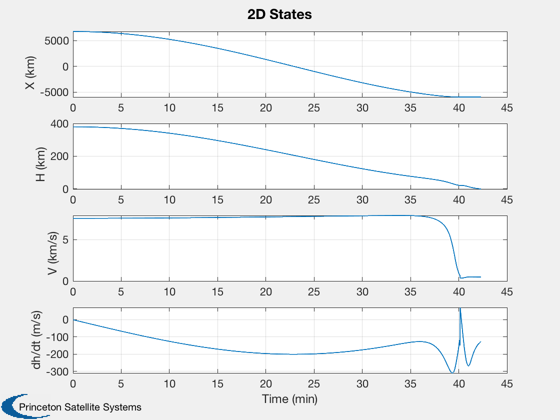
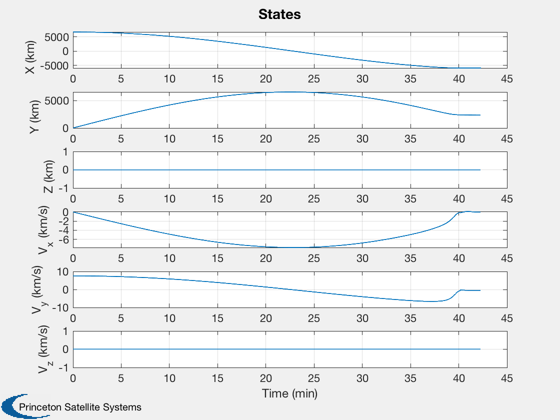
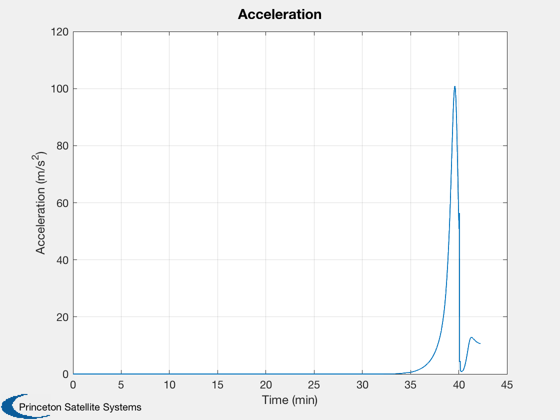
Plot the heat flux
[t, tL] = TimeLabl( q.time );
yL = {'Heat Flux (W/m^2)'};
Plot2D( t, qDot, tL, yL, 'Heat Flux ' );
Figui;
%--------------------------------------
